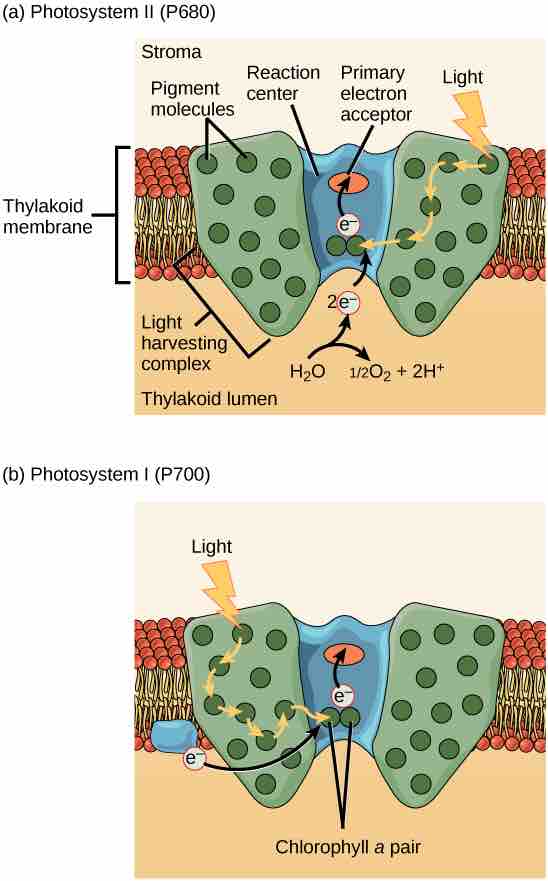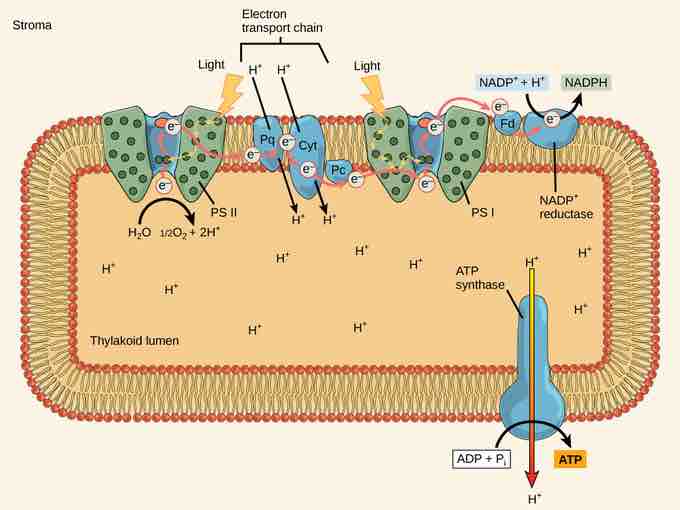How Light-Dependent Reactions Work
The overall function of light-dependent reactions, the first stage of photosynthesis, is to convert solar energy into chemical energy in the form of NADPH and ATP, which are used in light-independent reactions and fuel the assembly of sugar molecules. Protein complexes and pigment molecules work together to produce NADPH and ATP.
Producing Chemical Energy
Light energy is converted into chemical energy in a multiprotein complex called a photosystem. Two types of photosystems, photosystem I (PSI) and photosystem II (PSII), are found in the thylakoid membrane inside the chloroplast . Each photosystem consists of multiple antenna proteins that contain a mixture of 300–400 chlorophyll a and b molecules, as well as other pigments like carotenoids. Cytochrome b6f complex and ATP synthase are also major protein complexes in the thylakoid membrane that work with the photosystems to create ATP and NADPH.

Photosystems I & II
A photosystem consists of a light-harvesting complex and a reaction center. Pigments in the light-harvesting complex pass light energy to two special chlorophyll a molecules in the reaction center. The light excites an electron from the chlorophyll a pair, which passes to the primary electron acceptor. The excited electron must then be replaced. In (a) photosystem II, the electron comes from the splitting of water, which releases oxygen as a waste product. In (b) photosystem I, the electron comes from the chloroplast electron transport chain.
The two photosystems absorb light energy through proteins containing pigments, such as chlorophyll. The light-dependent reactions begin in photosystem II . In PSII, energy from sunlight is used to split water, which releases two electrons, two hydrogen atoms, and one oxygen atom. When a chlorophyll a molecule within the reaction center of PSII absorbs a photon, the electron in this molecule attains a higher energy level. Because this state of an electron is very unstable, the electron is transferred to another molecule creating a chain of redox reactions called an electron transport chain (ETC). The electron flow goes from PSII to cytochrome b6f to PSI; as electrons move between these two photosystems, they lose energy. Because the electrons have lost energy prior to their arrival at PSI, they must be re-energized by PSI. Therefore, another photon is absorbed by the PSI antenna. That energy is transmitted to the PSI reaction center. This reaction center, known as P700, is oxidized and sends a high-energy electron to reduce NADP+ to NADPH. This process illustrates oxygenic photosynthesis, wherein the first electron donor is water and oxygen is created as a waste product.

Photosystem II
In the photosystem II (PSII) reaction center, energy from sunlight is used to extract electrons from water. The electrons travel through the chloroplast electron transport chain to photosystem I (PSI), which reduces NADP+ to NADPH. The electron transport chain moves protons across the thylakoid membrane into the lumen. At the same time, splitting of water adds protons to the lumen while reduction of NADPH removes protons from the stroma. The net result is a low pH in the thylakoid lumen and a high pH in the stroma. ATP synthase uses this electrochemical gradient to make ATP.
Cytochrome b6f and ATP synthase work together to create ATP. This process, called photophosphorylation, occurs in two different ways. In non-cyclic photophosphorylation, cytochrome b6f uses the energy of electrons from PSII to pump hydrogen ions from the lumen (an area of high concentration) to the stroma (an area of low concentration). The energy released by the hydrogen ion stream allows ATP synthase to attach a third phosphate group to ADP, which forms ATP . This flow of hydrogen ions through ATP synthase is called chemiosmosis because the ions move from an area of high to an area of low concentration through a semi-permeable structure. In cyclic photophosphorylation, cytochrome b6f uses the energy of electrons from both PSII and PSI to create more ATP and to stop the production of NADPH. Cyclic phosphorylation is important to maintain the right proportions of NADPH and ATP, which will carry out light-independent reactions later on.
The net-reaction of all light-dependent reactions in oxygenic photosynthesis is: 2H2O + 2NADP+ + 3ADP + 3Pi → O2 + 2NADPH + 3ATP